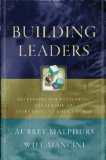Sample Chapter: The Challenge of Empowerment
In 2001 I was traveling in San Francisco to consult navigate with my mentor and friend Aubrey Malphurs. Aubrey had written about 10 books at the time and was brainstorming a three-part series on leadership with Baker Books. He had written the first book, Being Leaders (The Nature of Authentic Christian Leadership) and was strategizing for his second book. Being Leaders laid a biblical framework for the nature and identity of spiritual leadership. The next book would shift to praxis- how does a pastor really develop leaders at every level in their church? I had a blast discussing ideas with Aubrey as we drove.
What do I like best about Building Leaders (Blueprints for Developing Leaders at Every Level in Your Church)? The book has substance for those who really want to build a leadership development process for their church. The substance has two scoops of flavor: Aubrey brings the clear, simple, process orientation that makes the journey of leadership development accessible irregardless of the pastor’s leadership gifting. My contribution adds to the art of leadership—what are the challenges to the leader’s heart in releasing others? How do the nuances of centralization and decentralization affect the process? How do you build a leadership culture? One unique thing I developed for the leadership development process designer in the church is a consumer reports-like charting system to evaluate the 16 basic leadership venues. I searched desperately for something like this when I was designing a process at Clear Creek. Well, I never found it so I ended up creating something that I would have loved to come across.
What is the down side of the book? Well the book is not a light read, but a practical reference book. Frankly, the topic of serious leadership development is not sexy, because so many churches are duped by crowd fixation. They accomplish growth by leveraging the momentum of the crowd. The Sunday program becomes such an end-all-be-all, who has time do dive into a serious book on building leaders? Church leaders today rarely think like Jesus did. Our savior launched a worldwide movement of redemption by investing 75% of his energy into the twelve. How big would Jesus’ church plant be after 3 years? About 120. The average mega-church pastor today, however, is an exception if he manages to invest even 10% of his energy into leaders. After all, Sunday is coming! Therefore, Building Leaders is only useful if the reader has a conviction that the church is at its best with a robust infrastructure of disciple-making leaders.
The third book in the series eventually released as Leading Leaders (Empowering Church Boards for Ministry Excellence). Aubrey wrote this book solo and it is one of his best. It focuses primarily on dynamics with church boards and elder teams and provides a unique wealth of information both theologically and practically on church governance. The series makes a very nice set.





